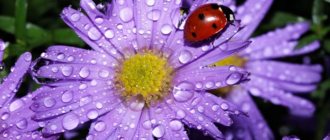Author: Elena N. https://floristics.info/ru/index.php?option=com_contact&view=contact&id=19 Category: Garden plants Published: February 03, 2019Last edits: August 14, 2021
- Growing conditions
- Liatris spicata
plant (lat. Liatris) belongs to the genus of perennial beautifully flowering herbaceous plants of the Asteraceae, or Asteraceae, family, growing naturally in Mexico, North America and the Bahamas. In their natural habitats there are about twenty species of liatris. The name of the plant is formed from two Greek words, translated meaning “smooth” and “doctor”. In our country, liatris flowers are sometimes called “deer tongue” or “cheerful feathers.” In garden culture, liatris is grown not so much because of the undeniable decorativeness of its candle inflorescences, but primarily for its amazing smell, combining the finest aroma of vanilla and notes of fresh hay. Humans are attracted to the smell of liatris, but moths cannot stand it: just one sprig of liatris placed in a clothes closet is enough for the harmful insect to leave your woolen sweaters alone.
Planting and caring for liatris
- Planting: early spring or autumn.
- Flowering: June-July.
- Lighting: bright sunlight.
- Soil: fresh, loose, moderately dry, nutritious.
- Watering: as needed.
- Hilling: regular, instead of loosening, since the plant has a superficial root system.
- Mulching: mandatory.
- Garter: tall varieties need to be tied to a support.
- Fertilizing: with mineral fertilizers three times per season: in the spring - nitrogen, in the summer - potassium-phosphorus.
- Reproduction: by seeds and dividing the bush.
- Pests: slugs, snails and mole crickets.
- Diseases: gray and root rot.
Read more about growing liatris below.
What can harm this plant?
If we talk about pests, then most likely the bush can be damaged by pests such as mole crickets, snails, and slugs.
If we talk about diseases, then the flower is most susceptible to gray or brown rot. In order to avoid such an unpleasant disease, it is necessary to use antifungal agents or folk recipes using mustard solution or iodine solution.
If you provide this unpretentious plant with the minimum appropriate care, it will delight its owners with magnificent double flowers rushing upward to the sky.
Botanical description
Liatris flower is a perennial rhizomatous plant with simple or branched erect stems, densely foliated alternate or whorled pointed linear leaves. The tuberous roots of Liatris, similar to bulbs, are connected to each other by thin roots. With the right location and good care, the height of liatris can reach two meters. Tubular reddish-purple, violet-purple, pink, red and white flowers form baskets, which in turn are collected in spike-shaped or racemose inflorescences up to half a meter long.
Liatris blooms in summer, and unlike other flowers, liatris begins to bloom from the top, not from the bottom, of the inflorescence. Liatris fruits are oblong ribbed achenes covered with hair. Liatris is used in landscape design both as a solo plant and in combination with other flowers - gypsophila, brunnera, verbena, phlox, armeria. Liatris flower stalks stand well when cut - up to ten days, and the dried inflorescences are used to create winter bouquets.
4. Application in landscape design
Flowers are often planted in small groups in the center of flower beds or flower beds - this way they will look more impressive. When grown in the garden, liatris will require minimal care, and its long and abundant flowering will attract many beneficial insects to the site.
Since plants can thrive even in soils that are quite poor in nutrients, this flower can decorate the slopes of an alpine hill.
Small varieties can be used as a border, bordering flower beds or highlighting garden paths.
↑ Up,
Growing Liatris from Seeds
Liatris is propagated by seed seedlings and without seedlings, but the plant is so life-loving, cold-resistant and unpretentious that it makes no sense to waste time and effort growing seedlings. Seeds are sown before winter or early spring directly into open ground, since they are not afraid of frost, but before sowing, the seeds need to be soaked for half a day in a humate solution.
- Tansy: properties, cultivation, types and varieties
The soil is first dug up with organic matter, adding a bucket of humus to the soil per square meter of land; grooves 1-1.5 cm deep are made for the seeds. The seeds are evenly distributed along the furrow, sprinkled with soil on top and watered. However, a gardener who prefers to grow liatris with seeds should know that the plant reaches full growth and full flowering only in the second or third year after planting. In addition, liatris produces abundant self-seeding in the fall, so in the spring all that remains is to thin out the seedlings.
Planting Liatris
When to plant
The easiest way to propagate the perennial liatris is by vegetative means. If you already have liatris growing on your site, you can get planting material in August or September by dividing the liatris tuber into parts. Planting material is also sold in flower shops. But first you need to choose a site where the plant will grow comfortably. An open sunny place is suitable for liatris. Direct rays will not harm it, and Liatris is indifferent to high temperatures, so it will withstand the July heat.
The soil is preferably loose, nutritious and well-drained: what liatris is afraid of is water in the roots, from which its root system quickly rots, so heavy damp substrates and areas in lowlands, hollows and in places with soil close to the surface are not suitable for it water Liatris is planted in early spring or autumn.
How to plant
Tubers, depending on their size, are planted to a depth of 3-10 cm, keeping a distance of 15-20 cm between specimens. After planting, the liatris is watered, then the area is mulched with humus.
Reproduction method using shoots
In the case of propagation by shoots, it is necessary to take the basal shoots. It is this method that will ensure a fairly quick production of a healthy, full-fledged bush.
In order to carry out this method of planting liatris, it is necessary to follow the following sequence of actions:
- Carefully separate the shoot from the mother plant;
- it must be carefully selected so that it has its own, well-developed root system;
- a hole about 20-25 cm deep is dug under each shoot;
- then humus must be placed at the bottom of the hole, filling the hole to approximately 20-25% of the full depth;
- then place the seedling in the hole so that it is deepened by 10-15 cm.
Fact!
If there is a need to periodically pick off seedlings and plant new plants, then it is worth considering that you should not regularly take cuttings from one mother bush - this will cause the plant to die. You can separate cuttings once every 2-4 years without causing much harm to the mother plant.
Liatris care
Growing conditions
Caring for a liatris flower consists of watering it as needed, removing weeds, and periodically hilling up the bushes instead of loosening the soil, since the root system of the plant is superficial and can be exposed during prolonged rains. For the same reason, there is a need to add soil to the site. Tall liatris flower stalks sometimes have to be tied to a support. Do not neglect mulching the area, which, by protecting and nourishing the roots of the plant, significantly reduces the labor intensity of caring for liatris.
In addition, liatris needs to be fertilized with mineral fertilizers, which are applied three times per season: in the spring the plant is fed with nitrogen fertilizer, in the summer with potassium-phosphorus fertilizer. It is also necessary to prune the wilted inflorescences of the liatris so that the plant does not lose its decorative effect and even after flowering pleases the eye with the bright greenery of its foliage.
- 6 basic rules for planting seedlings - avoid common mistakes
Transfer
Liatris transplantation in the fall is usually carried out simultaneously with dividing the tuber once every three to four years. Liatris is dug up, the bush is carefully divided into parts so that each division has a root collar with tubers, then the divisions are planted in holes at a distance of 25 to 40 cm from each other, deepening the tubers into the ground by 8-15 cm. A third of the hole is filled up humus, then supplement it with garden soil and compact it. After watering, the area is mulched with humus.
Pests and diseases
As you can see, planting and caring for liatris in open ground is simple and easy. Liatris is as unpretentious as it is resistant to diseases, but it can be harmed by mole crickets and snails. In the fight against them, a folk method is successfully used: a bottle with 100 ml of beer is dug into the ground at an angle of 45º so that the neck is 2-3 cm below the surface level, in a small hole. Mole crickets and snails crawl towards the smell of beer and end up in a trap. The complexity of the method is that the beer needs to be changed in the bait regularly.
Sometimes the plant begins to rot due to waterlogging. In this case, all rotting places on the ground part of the plant should be cut off, then the liatris is treated with a fungicide. If the cause of the disease is close groundwater or too heavy soil, you should think about changing the area for liatris.
7.The healing properties of a garden flower
In addition to its visual appeal, liatris is also used in folk medicine. It is believed that plants can get rid of colic, as they can relieve spasms in the intestines.
Previously, decoctions of the plant were used for snake bites; currently, lotions are made from it for insect bites. The decoction can reduce discomfort and itching.
↑ Up,
The anti-inflammatory properties of the flower are used for sore throats - gargle with a decoction. Rhizomes are used for various skin diseases. The green mass has a diuretic effect and is used for kidney and bladder diseases.
Interestingly, the beneficial properties of the flower do not end there. The fact is that the aroma of flowers repels moths and it is enough to put a few sprigs of dried flowers in the closet to repel these insects for a long time.
↑ Up,
Types and varieties
Three types of liatris are grown in culture: spikelet, filmy and rough.
Liatris spicata
Native to southeastern North America. Its heavily leafy stems reach a height of only 50 cm. The leaves are linear. Small baskets of 8-13 tubular flowers are collected in spike-shaped inflorescences up to 35 cm long. Flowering begins in June or July and lasts 35-40 days. In culture since 1732.
The most famous varieties of liatris spikelet are Floristan Weiss, up to 90 cm high with white flowers, Floristan Violet, up to 80 cm high with purple inflorescences, Kobold - liatris up to 40 cm tall with pink-purple inflorescences.
- Calla tuberous. We asked - we answer
Liatris aspera
A rare species with small lavender-pink flowers, forming long fluffy inflorescences. The stem is up to 1 m high, the leaves are lanceolate and shiny. This is the tallest species among liatris. There is a variety with white inflorescences - White Spire.
Liatris scariosa
It is distinguished by wider leaves - up to 3 cm wide, its inflorescences are pink-lilac, dark in color. The Alba variety has white flowers, and September Glory is distinguished by large bright pink inflorescences and a meter-high peduncle.
general information
It’s hard to believe when looking at the inflorescences of Liatris, but in fact it belongs to the Asteraceae. In nature, it lives in Mexico, certain regions of America and on the islands. In addition to the unusual candle inflorescences, liatris is notable for its original aroma, which contains notes of vanilla and freshly cut grass.
In its natural environment, liatris is a perennial with a complex root system of small tubers and thin roots. Its shoots are branched or ordinary, and under favorable conditions the bush grows up to 2 m. Liatris has linear sharp leaves, and the length of the inflorescences reaches 50 cm.
Flowers bloom from top to bottom, and white and pink shades are most common. Liatris is also grown as a cut flower for bouquets, and is also dried for decoration and winter arrangements.
Photo: cvetyphoto.blogspot.com











